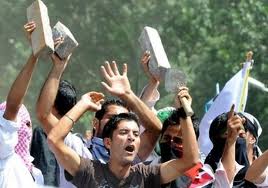 New Delhi, August 28: Senior IPS officer N C Asthana of CRPF was today at the centre of a controversy over his remarks that there was a "strong under-current against India" in Kashmir, prompting the Home Ministry to take action, if required.
New Delhi, August 28: Senior IPS officer N C Asthana of CRPF was today at the centre of a controversy over his remarks that there was a "strong under-current against India" in Kashmir, prompting the Home Ministry to take action, if required.
52-year-old Asthana, a 1986 batch IPS officer from Kerala, has penned down a book "India's Internal Security: The Actual Concerns" along with his wife Anjali Nirmal, who holds a doctorate in police administration, which speaks about his tenure in the Valley during 2010 unrest.
His remarks have been hailed by hardline Hurriyat Conference led by Syed Ali Shah Geelani and main opposition in the state PDP.
In an interview to a weekly, Asthana had said "there is a strong under-current against India" and that heavy turn-out in elections or flow of tourists should not be read as return of normalcy in the state.
When contacted, a spokesperson of the Ministry of Home Affairs said, "MHA is siezed of the matter. We are examining the content of the book. If required, action will be taken."
Asthana, who is at present posted as Inspector General of CRPF, looking after anti-naxal unit CoBRA, refused to answer any questions saying that he has written whatever he had, in the book.
"I do not wish to give any interviews or answer any questions," Asthana, who was shunted out from the Valley after CRPF had fired indiscriminately on protestors in Bomai area or Sopore in North Kashmir, said.

CRPF Director General K Vijay Kumar declined to comment on the controversy.
Asthana, according to officials, had given an undertaking that there was no malafide intention in writing the book. ccording to section 6 of All India Services rules, no official shall publish anonymously, pseudonymously or in his own name or in the name of any other person or in any communication to the press or in any public utterance, make any statement of fact or opinion which is against the interests of the Centre or state government.
Hardline faction of Hurriyat Conference led by Syed Ali Shah Geelani has already welcomed the comments and observations made by the serving IPS officer.
Opposition PDP welcomed the statement of Asthana saying this had vindicated their stand.
"It vindicates our stand and it's a good development that it comes from an officer who was in charge of security at ground zero. This should serve as a valuable input for all those who frame policies on Kashmir," PDP's chief spokesperson Nayeem Akhtar said.
To a question on the official's observation about anti-India sentiments in Kashmir, he said "there is a sentiment but it has to be addressed. It is not completely anti-India. Sometimes local reasons, when not addressed because of misgovernance, lead to trouble and then shapes up in anti-India sentiments. So its better to address the issues at the very beginning."
Jammu and Kashmir BJP spokesperson Jitendra Singh termed Asthana's comments incorrect and said "this observation is statically as well as factually incorrect and subjective opinion.
"There is no authentic data to support the observation made by the author and as a general statement of opinion of a small section of population, if any, cannot be accepted as a view of the people of the state"





Comments
Add new comment